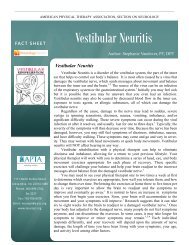Practice Guidelines for BPPV - Neurology Section
Practice Guidelines for BPPV - Neurology Section
Practice Guidelines for BPPV - Neurology Section
You also want an ePaper? Increase the reach of your titles
YUMPU automatically turns print PDFs into web optimized ePapers that Google loves.
Vestibular SIG Newsletter <strong>BPPV</strong> Special Edition<br />
Figure 3<br />
Figure 3. In the head left position of the DHT, the open end of the ampullary segment<br />
of both ACs point downwards at about 40° from vertical. This enables debris to settle<br />
within both ACs potentially activating both canals.<br />
Figure 4<br />
Figure 4. In the DHT with neck extension and no rotation, the debris clears the curvature of the long<br />
arm of both ACs potentially activating both canals.<br />
19<br />
with positional downbeating nystagmus and no<br />
primary gaze downbeating nystagmus, 75% of 50<br />
consecutive patients had evidence of CNS dysfunction<br />
suggesting CNS dysfunction as the probable cause of<br />
positional downbeating nystagmus and 25% had<br />
idiopathic positional downbeating nystagmus 4 .<br />
There<strong>for</strong>e the differential diagnosis needs to be made<br />
based on history, and findings on neurologic<br />
examination and positional testing.<br />
Particle Repositioning Maneuvers <strong>for</strong> Treatment of<br />
AC- <strong>BPPV</strong><br />
Neck Extension – Side Involved Unknown<br />
If the bilateral DHT and/or the straight head hanging<br />
position evoke pure downbeating nystagmus with no<br />
torsional component, AC-<strong>BPPV</strong> may be suspected but<br />
the side involved is unknown. If the involved ear is<br />
unknown, cervical extension over the edge of the<br />
table in the<br />
recumbent position should enable otoconia to clear<br />
the curvature of both ACs 13 . A minimum of 60° of<br />
cervical extension is needed 12 . To per<strong>for</strong>m the<br />
maneuver, the patient sits on the examination table<br />
(Figure 5) 13 . The patient is brought into the<br />
recumbent position with the head extended over the<br />
edge of the table. The position is held <strong>for</strong> 2 minutes to<br />
provide adequate time <strong>for</strong> the debris to settle in the<br />
AC. The patient is returned to the upright position.<br />
This maneuver is repeated 3 times.<br />
360° Forward Rotation – Side Involved Identified<br />
If the bilateral DHT evokes pure downbeating<br />
nystagmus with a small torsional component, the<br />
direction of the torsion vector will be towards the<br />
involved ear 4 . Once the involved ear is identified, a<br />
360° <strong>for</strong>ward rotation around the AC clears the debris<br />
from the canal into the vestibule (Figure 6) 14 . During<br />
the maneuver, the therapist supports the patient’s<br />
head. Caution must be taken to ensure that the neck<br />
is kept in alignment and not strained and that the<br />
patient does not have spinal dysfunction that would<br />
limit the patient’s ability to participate in the

















